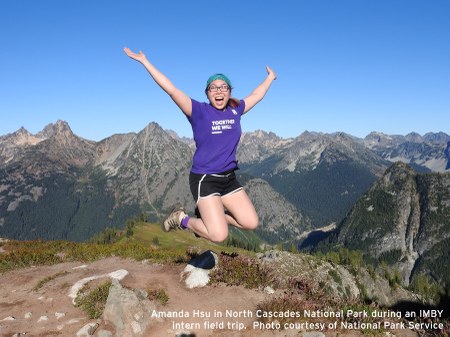
by Amanda Hsu, National Parks Service In My Backyard Intern
When I first applied for an internship with the In My Backyard program in the National Park Service, it seemed almost impossible for someone like me to join.
As a young woman born and raised in the suburbs of Thousand Oaks, California, I didn’t grow up with a hiking pole in hand, but I soon realized I possessed a key to helping people belong in national parks. National parks hold our histories. They tell our stories. No matter who we are, what we look like, or where we come from, our national parks are spaces where we all belong.
In My Backyard was founded along the lines of these exact principles. Rangers at Klondike Gold Rush National Historical Park-Seattle established the program in 2013. Park rangers, teachers, volunteers, Student Conservation Association interns, and university students have been working tirelessly to resolve an enduring problem: How does the National Park Service connect with communities that the agency has long underserved and, in many cases, ignored? Knowing they didn’t have all the answers, rangers tapped into Seattle’s dynamic university student community to help find answers. In My Backyard is student-driven, making it one of the first programs of its kind within the Park Service. For example, as an In My Backyard intern, I was directly responsible for designing a mobile park that the program will take to communities that may not have access to parks.
I am a Chinese Filipino student currently taking a year off from attending my studies in Environmental Science and Resource Management at the University of Washington. At this moment in my life, I am finding my passion and self-identity. I am finding how I belong. For me, and like many others, the path to belonging has been challenging.
Growing up, I was a chubby, painfully shy girl who didn’t fit in. But I am grateful for that girl. She taught me that stepping out of my comfort zone is well worth the sweaty palms and apprehension. Most importantly, she taught me to live with integrity. By doing so, I found my familial tribe of queer folk, band geeks, tree huggers, and underdogs.
By the time high school reared its ugly face, I was just becoming comfortable with my sexuality. Being gay was somewhat of a taboo in my conservative hometown, so I felt isolated. With close friends or with just my mom, we found solace in our own backyard at Santa Monica Mountains National Recreational Area, San Buenaventura State Beach, and Wildwood Park, among many others. These were places for reflection where I didn’t have to fear judgment. Still, I desired to find people to relate to. It wasn’t until my first Pride Parade in Los Angeles that I felt a connection to the LGBT community.
On June 24, 2016, President Obama designated Stonewall National Monument as the Park Service’s first unit dedicated to LGBTQ rights. Two days later, I attended my first Seattle Pride Parade and was the proudest to see NPS employees from across the Pacific Northwest bearing a banner that read “#Stonewall.” I didn’t think it would be possible, but to see my passion for environmental stewardship and my sexuality connected and celebrated right before me truly made me feel like I belonged. I was able to find a community 1,100 miles away from my friends and family in California, and I knew I could translate that same approach into helping others find their connection to national parks.
I want to evoke a strong sense of belonging among high school students. I want them to realize their own unique sense of place within parks. As the lead designer for a mobile national park in downtown Seattle, I am incorporating personal narratives from people of all ages, gender, sex, race, ethnicity, sexual orientation, and ability by sharing their stories involving conservation, community, and national parks. It is from these unique personal perspectives that I hope young people discover, like I have, their own interconnections within the National Park Service – and realize they belong.
Add a comment
Log in to add comments.You fraking rock!
 Suzanne Gerber
Suzanne Gerber